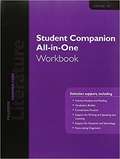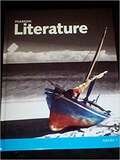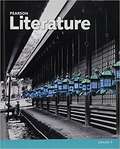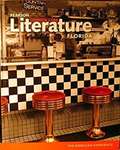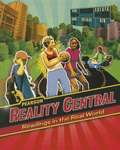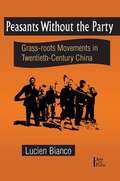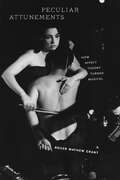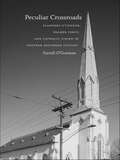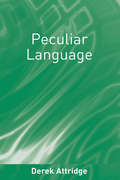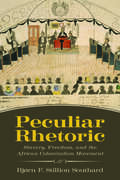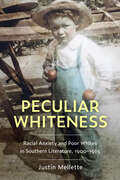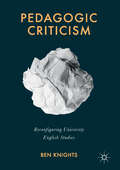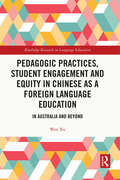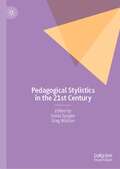- Table View
- List View
Pearson Language Central: ELD [Grade 5]
by Jim Cummins Georgia Garcia Lily Wong FillmoreNIMAC-sourced textbook
Pearson Literature 2015 Common Core Student Companion All-in-one Workbook Grade 10
by Prentice-Hall StaffPearson Literature 2015 Common Core Student Companion All-In-one Workbook Grade 10
Pearson Literature 2015 Student Edition Grade 07
by Prentice-Hall StaffPEARSON LITERATURE 2015 STUDENT EDITION GRADE 07
Pearson Literature 2015 Student Edition Grade 09
by Prentice-Hall Staff“The contributing authors guided the direction and philosophy of Pearson Literature. They helped to build the pedagogical integrity of the program by contributing content expertise, knowledge of the learning standards, and support for the shifts in instruction that are necessary for college and career readiness. Their knowledge, combined with classroom and professional experience, ensures that Pearson Literature is relevant for both teachers and students.” – from the Book.
Pearson Literature 2015 Student Edition Grade 6
by Prentice HallA language arts textbook for grade 6 students.
Pearson Literature Common Core (Florida Edition) (Grade 10 )
by Lawrence Scanlon Robin Dissin Aufses Renee H. SheaThe Language of Composition is the first textbook built from the ground up to help students succeed in the AP English Language course. Written by a team of experts with experience in both high school and college, this text focuses on teaching students the skills they need to read, write, and think at the college level. With practical advice and an extensive selection of readings — including essays, poetry, fiction, and visual texts — The Language of Composition helps students develop the key skills they must master to pass the course, to succeed on the AP Exam, and to prepare for a successful college career. Revised based on feedback from teachers across the country, the second edition promises to be an even better resource for the AP Language classroom.
Pearson Literature Common Core Grade 9
by PearsonPearson Literature Common Core Grade 9 will enable students to read and comprehend literature, including stories, dramas, and poems.
Pearson Literature Common Core: The American Experience (Florida Edition)
by PearsonThe selections in this book are presented through the lens of three Essential Questions: (i) What makes American literature American? (ii) What is the relationship between literature and place? and (iii) How does literature shape or reflect society?
Pearson Literature: California Reading and Language, Grade Eight
by Pearson EducationNIMAC-sourced textbook
Pearson Literature: Reading and Language (Grade 7, California Edition)
by PearsonThe California program advisors provided input during the development of Pearson Literature. Their valuable insights ensure that the perspectives of the teachers throughout the state are represented within the literature series.
Pearson Reality Central: Readings in the Real World [Grade 6]
by Pearson EducationNIMAC-sourced textbook
Pearson Reality Central: Readings in the Real World [Grade 8]
by Prentice HallReality Central is a nonfiction anthology featuring short, high interest, readings on topics and issues students encounter every day. Selections are written slightly below grade level to reach all readers, making the program ideal for English Learners and striving readers. The passages in Reality Central align with the topics, skills, and Big Question in Prentice Hall Literature ©2010, and is flexible enough to be used as a stand-alone program. Use Reality Central for a class starter, homework, or independent activities for those needing extra reading practice. Reality Central supports below level readers' development of skills such as: Vocabulary development-Pre and post reading support Connection to background knowledge for success in Lit program Targeted writing instruction Discussion opportunities The accompanying Writing Journal gives students complete writing support, guided practice, and extensive vocabulary support, including graphic organizers. The Teaching Guide includes correlations to Prentice Hall Literature and complete support for every topic and theme.
Peasants without the Party: Grassroots Movements in Twentieth Century China (Asia And The Pacific Ser.)
by Lucien BiancoExploring one of the most dynamic and contested regions of the world, this series includes works on political, economic, cultural, and social changes in modern and contemporary Asia and the Pacific.The leading specialist on China's twentieth century peasant resistance reexamines, in bold and original ways, the question: Was the Chinese peasantry a revolutionary force? Where most scholarly attention has focused on Communist-led peasant movements, Bianco's story is one of peasant thought and action largely unmediated by modern political parties. This volume pays particular attention to the first half of the twentieth century when peasant-based conflict, ranging from tax and food protests to secret society conflicts, opium struggles, inter-communal conflicts, and tenant protests over rent, was central to nationwide revolutionary processes.
Peculiar Attunements: How Affect Theory Turned Musical
by Roger Mathew GrantPeculiar Attunements places the recent turn to affect into conversation with a parallel movement in European music theory of the eighteenth century. During that time the affects—or passions, as they were also called—formed a vital component of a mimetic model of the arts. Eighteenth-century critics held that artworks imitated or copied the natural world in order to produce copies of the affects in their beholders. But music caused a problem for such theories, since it wasn’t apparent that musical tones could imitate anything with any dependability, beyond the rare thunderclap or birdcall.Struggling to articulate how it was that music managed to move its auditors without imitation, certain theorists developed a new affect theory crafted especially for music, postulating that music’s physical materiality as sound vibrated the nerves of listeners and attuned them to the affects through sympathetic resonance. This was a theory of affective attunement that bypassed the entire structure of representation, offering a non-discursive, corporeal alternative. It is a pendant to contemporary theories of affect, and one from which they have much to learn. Inflecting our current intellectual moment through eighteenth-century music theory and aesthetics, this book offers a reassessment of affect theory’s common systems and processes. It offers a new way of thinking through affect dialectically, drawing attention to patterns and problems in affect theory that we have been given to repeating. Finally, taking a cue from eighteenth-century theory, it gives renewed attention to the objects that generate affects in subjects.
Peculiar Crossroads: Flannery O'Connor, Walker Percy, and Catholic Vision in Postwar Southern Fiction (Library of Southern Civilization)
by Farrell O'GormanIn Peculiar Crossroads, Farrell O'Gorman explains how the radical religiosity of both Flannery O'Connor's and Walker Percy's vision made them so valuable as southern fiction writers and social critics. Via their spiritual and philosophical concerns, O'Gorman asserts, these two unabashedly Catholic authors bequeathed a postmodern South of shopping malls and interstates imbued with as much meaning as Appomattox or Yoknapatawpha. O'Gorman builds his argument with biographical, historical, literary, and theological evidence, examining the writers' work through intriguing pairings, such as O'Connor's Wise Blood with Percy's The Moviegoer, and O'Connor's A Good Man Is Hard to Find with Percy's Lancelot. An impeccable exercise in literary history and criticism, Peculiar Crossroads renders a genuine understanding of the Catholic sensibility of both O'Connor and Percy and their influence among contemporary southern writers.
Peculiar Language: Literature As Difference From The Renaissance To James Joyce
by Derek AttridgeFirst published in 1988, Peculiar Language is now established as one of the most important discussions of the language of literature. This thought-provoking book challenges traditional notions of literary criticism, arguing that all attempts by writers, critics and literary theorists to define the language of literature have involved self-contradiction. Through examination of key moments in literary history, Derek Attridge demonstrates that such contradictions in accounts of literary language are embedded in our cultural concept of 'literature' and asserts that in order to appreciate the forces that determine the limits of literary language, we must look beyond the realm of the 'literary' and embrace the wider political and social sphere. Re-issued as a result of sustained critical interest in the book, this edition includes a new preface by the author.
Peculiar Rhetoric: Slavery, Freedom, and the African Colonization Movement (Race, Rhetoric, and Media Series)
by Bjorn F. Stillion SouthardWinner of the 2020 Marie Hochmuth Nichols Award from the Public Address Division of the National Communication AssociationThe African colonization movement occupies a troubling rhetorical territory in the struggle for racial equality in the United States. For white colonizationists, the movement seemed positioned as a welcome compromise between slavery and abolition. For free blacks, colonization offered the hope of freedom, but not within America’s borders. Bjørn F. Stillion Southard indicates how politics and identity were negotiated amid the intense public debate on race, slavery, and freedom in America. Operating from a position of power, white advocates argued that colonization was worthy of massive support from the federal government. Stillion Southard pores over the speeches of Henry Clay, Elias B. Caldwell, and Abraham Lincoln, which engaged with colonization during its active deliberation. Between Clay’s and Caldwell’s speeches at the founding of the American Colonization Society (ACS) in 1816 and Lincoln’s final public effort to encourage colonization in 1862, Stillion Southard analyzes the little-known speeches and writings of free blacks who wrestled with colonization’s conditional promises of freedom. He examines an array of discourses to probe the complex issues of identity confronting free blacks who attempted to meaningfully engage in colonization efforts. From a peculiarly voiced “Counter Memorial” against the ACS to the letters of wealthy black merchant Louis Sheridan negotiating for his passage to Liberia to the civically minded orations of Hilary Teage in Liberia, Stillion Southard brings to light the intricate rhetoric of blacks who addressed colonization to Africa.
Peculiar Whiteness: Racial Anxiety and Poor Whites in Southern Literature, 1900-1965
by Justin MellettePeculiar Whiteness: Racial Anxiety and Poor Whites in Southern Literature, 1900–1965 argues for deeper consideration of the complexities surrounding the disparate treatment of poor whites throughout southern literature and attests to how broad such experiences have been. While the history of prejudice against this group is not the same as the legacy of violence perpetrated against people of color in America, individuals regarded as “white trash” have suffered a dehumanizing process in the writings of various white authors. Poor white characters are frequently maligned as grotesque and anxiety inducing, especially when they are aligned in close proximity to blacks or to people with disabilities. Thus, as a symbol, much has been asked of poor whites, and various iterations of the label (e.g., “white trash,” tenant farmers, or even people with a little less money than average) have been subject to a broad spectrum of judgment, pity, compassion, fear, and anxiety. Peculiar Whiteness engages key issues in contemporary critical race studies, whiteness studies, and southern studies, both literary and historical. Through discussions of authors including Charles Chesnutt, Thomas Dixon, Sutton Griggs, Erskine Caldwell, Lillian Smith, William Faulkner, and Flannery O’Connor, we see how whites in a position of power work to maintain their status, often by finding ways to recategorize and marginalize people who might not otherwise have seemed to fall under the auspices or boundaries of “white trash.”
Pedagogic Criticism
by Ben KnightsThis book argues that the history of English Studies is embedded in its classroom practice, and its practice in its history. Some of its foundational struggles are still being lived out today. English is characterized as a 'boundary' subject, active in dialogue across a number of imagined borders, especially those between academic and non-specialized readerships. While the subject discipline maintains strong pedagogic principles, many of its principles and values are obscure or even invisible to students and potential students. The book cross-fertilizes the study of English as a subject with the analysis of selected literary texts read as pedagogic parables. It concludes with a call for a return to the subject's pedagogic roots.
Pedagogic Practices, Student Engagement and Equity in Chinese as a Foreign Language Education: In Australia and Beyond (Routledge Research in Language Education)
by Wen XuThis book explores and analyses Chinese as a Foreign Language (CFL) pedagogic practices and learning experiences within a cohort of low socio-economic status students within an Australian primary classroom. It demonstrates that, in spite of policy and educational discourses underpinning ‘Asian literacies’, Chinese teaching and learning is a fragile undertaking in Australian schooling. The politicisation of CFL education, especially in the post COVID-19 era, has exacerbated public stereotypes concerning racism and multiculturalism in Australian classrooms today. Drawing upon Bernstein’s theorisation and engagement framework, Wen Xu sketches out CFL education as a democratic space where power and control relations can be deliberately operated to reinforce engaging learning experiences. She suggests that pedagogic interventions in the name of social justice have the potential to make consequential differences in disadvantaged students’ life trajectories, and CFL education can be envisioned as an avenue towards socioeconomic mobility instead of being criticised as a platform opposing to liberal ideas. In turn, she provides insights into teaching younger age CFL learners in the global context, in terms of the structuring of pedagogy and curriculum. Wen Xu’s research will be of interest to students and scholars in sociology of education, student engagement, pedagogy and curriculum, CFL education and languages education, as well as pre-service teachers and practitioners who teach Chinese as a Foreign Language.
Pedagogical Opportunities of the Review Genre: Learning in Cultures of Evaluation (Routledge Research in Media Literacy and Education)
by Maarit JaakkolaPedagogical Opportunities of the Review Genre unleashes the pedagogical potential of the review genre, reframing the act of reviewing of cultural products as a communicative practice from a pedagogical perspective.Negotiating between traditions of journalism and media studies and pedagogy, the author presents a novel approach that will increase the readers’ understanding of an activity that is on the increase in an era where 'everyone can be a critic'. She identifies, describes, and develops genre-based pedagogies in formal, non-formal, and informal contexts of learning and teaching, in order to recontextualize the review as a form of learning and rethink of its potential as an inclusive, engaging, and a transformative critical cultural practice.This innovative and truly interdisciplinary study will interest students and researchers in the areas of media literacy, digital media, media and communication studies, cultural studies, sociology of arts, and pedagogical studies – in particular, cultural journalism and criticism, audience studies, cultural production, and cultural mediation, as well as critical media pedagogy and literacy studies.
Pedagogical Stylistics in the 21st Century
by Sonia Zyngier Greg WatsonThis edited book provides cutting edge contributions from an international array of prominent experts who discuss the relevance of pedagogical stylistics in relation to diverse contexts and areas, including empirical approaches, corpus stylistics, creative writing, literary-linguistic criticism, students as researchers, critical discourse, academic register, text-world pedagogy, cognitive stylistics, classroom discourse, language of literary texts, L1/L2 education, EFL learners, and multimodal stylistics. Intended as a follow-up to Watson and Zyngier (2007), this volume situates the reader by offering a broad assessment of how the field has developed during the past 15 years and where it stands now. By examining both contemporary research and future challenges, it should be regarded as essential reading for all teachers, researchers, scholars, and students interested in understanding language and how to apply stylistics in educational settings. This book will be of interest to students and scholars working in stylistics, cognitive linguistics, language teaching, applied linguistics, literary studies, and materials development.

